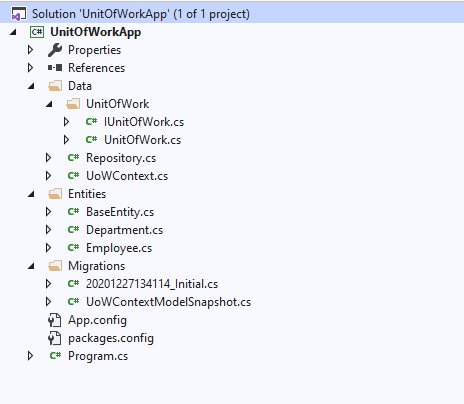Unit Of Work Pattern Nedir?
- 27 Dec, 2020

Merhaba Arkadaşlar, bu makalemde generic repository ile Unit of Work tasarım deseni nasıl kullanılır , ne işe yarar gibi konularını işleyeceğiz.
Generic Repository : Oluşturduğumuz bu sınıf , veritabanında karşılığı olan tüm tablolar için genel bir CRUD işlemlerini yapabilmemizi sağlar. Bu sayede kod okunabilirliğini arttırmışken DRY (Don’t Repeat Yourself) yazılım geliştirme ilkesini de çiğnememiş oluruz.
Unit Of Work : Veritabanı ile ilgili tüm işlemlerin tek kanaldan yapılmasını sağlayan ve yapılan tüm işlemlerin hafızada tutularak toplu halde gerçekleştirilmesini sağlayan bir tasarım desenidir.
O zaman gelin , beraber altyapıyı kuralım. Öncelikle çalışmak istediğimiz klasörde terminali başlatıp aşağıdaki komutu girerek “UnitOfWorkApp” adlı bir konsol uygulaması oluşturuyoruz.
dotnet new console -n UnitOfWorkApp
Solution içerisinde 2 adet klasörümüz bulunmakta. Bunlardan biri model sınıflarımızın olduğu “Entities” klasörü , diğeri de veritabanı ile ilgili sınıfların olduğu “Data” klasörümüz. Makale bitiminde aşağıdaki gibi bir hiyerarşik yapı oluşturmuş olacağız.

“Entities” klasörüne gelip model sınıflarımızı oluşturmaya başlayalım.
namespace UnitOfWorkApp.Entities
{
public class BaseEntity
{
public int Id { get; set; }
public DateTime CreatedAt => DateTime.Now;
}
}
public class Department:BaseEntity
{
public Department()
{
Employees = new List<Employee>();
}
public string Name { get; set; }
public string Location { get; set; }
public List<Employee> Employees { get; set; }
}
namespace UnitOfWorkApp.Entities
{
public class Employee:BaseEntity
{
public string FirstName { get; set; }
public string LastName { get; set; }
public int Salary { get; set; }
public string PhoneNumber { get; set; }
public string EmailAddress { get; set; }
public string Location { get; set; }
public int DepartmentId { get; set; }
public Department Department { get; set; }
}
}
“Data” klasörüne geçelim ve context sınıfımızı yazalım.
namespace UnitOfWorkApp.Data
{
public class UoWContext:DbContext
{
public DbSet<Employee> Employees { get; set; }
public DbSet<Department> Departments { get; set; }
protected override void OnConfiguring(DbContextOptionsBuilder optionsBuilder)
{
optionsBuilder.UseSqlServer("Data Source=DESKTOP-2QF0S4K;Initial Catalog=UoWDb;Integrated Security=True;");
base.OnConfiguring(optionsBuilder);
}
}
}
“Data” klasörünün içerisinde repository sınıfımızı yazalım.
namespace UnitOfWorkApp.Data
{
public interface IRepository<T>
{
IEnumerable<T> GetAll();
T Get(Expression<Func<T, bool>> predicate);
void Add(T entity);
void Update(T entity);
void Delete(T entity);
void Delete(int id);
}
public class Repository<T>:IRepository<T> where T: BaseEntity // Generic repository sınıfımızda sadece BaseEntity sınıfından kalıtılanlar kullanılabilir
{
private UoWContext context;
public Repository(UoWContext context)
{
this.context = context;
}
public IEnumerable<T> GetAll()
{
return context.Set<T>().ToList();
}
public T Get(Expression<Func<T, bool>> predicate)
{
return context.Set<T>().SingleOrDefault(predicate);
}
public void Add(T entity)
{
var currentEntity = context.Entry(entity);
currentEntity.State = EntityState.Added;
}
public void Update(T entity)
{
var currentEntity = context.Entry(entity);
currentEntity.State = EntityState.Modified;
}
public void Delete(T entity)
{
var currentEntity = context.Entry(entity);
currentEntity.State = EntityState.Deleted;
}
public void Delete(int id)
{
var currentEntity = context.Set<T>().SingleOrDefault(z => z.Id == id);
context.Set<T>().Remove(currentEntity);
}
}
}
Aynı klasörün içerisine “UnitOfWork” klasörü açalım ve gerekli sınıfları yazalım.
namespace UnitOfWorkApp.Data.UnitOfWork
{
public interface IUnitOfWork
{
public int Commit();
}
public class UnitOfWork:IUnitOfWork
{
private UoWContext context;
public IRepository<Employee> EmployeeRepository { get; private set; }
public IRepository<Department> DepartmentRepository { get; private set; }
public UnitOfWork(UoWContext _context)
{
this.context = _context;
EmployeeRepository=new Repository<Employee>(context);
DepartmentRepository=new Repository<Department>(context);
}
public int Commit()
{
return context.SaveChanges();
}
}
}
Şimdi ise veritabanını oluşturması için Package Manager Console’u açıyorum ve sırasıyla aşağıdaki komutları giriyorum.
Enable-Migrations
Add-Migration Init
Update-Database -verbose
Dikkat : Migration işlemi yaparken hata alırsanız EntityFrameworkCore.Tools ve EntityFramework.Design paketlerinin yüklü olduğundan emin olunuz.
Artık genel altyapıyı kurduk. Gelin beraber ana sınıfımızda testimizi yapalım.
namespace UnitOfWorkApp
{
class Program
{
static void Main(string[] args)
{
UnitOfWork unitOfWork=new UnitOfWork(new UoWContext());
unitOfWork.DepartmentRepository.Add(new Department
{
Location = "İstanbul",
Name = "Bilgi İşlem"
});//Ram'de tutuluyor
unitOfWork.EmployeeRepository.Add(new Employee()
{
DepartmentId = 1,
FirstName = "Abdullah",
LastName = "Öztürk",
EmailAddress = "oabdullahozturk@yandex.com.tr",
Location = "İstanbul",
});//Ram'de tutuluyor
unitOfWork.Commit();//Veritabanına kaydedildi.
Console.ReadKey();
}
}
}
Bu makalemde temel düzeyde unit of work tasarım deseninin kurumsal mimaride nasıl implemente edileceğini gördük.
Projenin github linkine buradan ulaşabilirsiniz.


